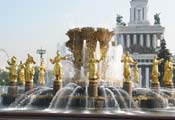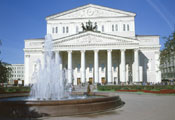
| Home » Regions » Russia » Moscow | |||
Moscow, Russia
 FOUNTAIN  BOLSHOI THEATER For almost nine centuries, Moscow has been a melting pot of cultures, ideas and perspectives. Russia is both an old nation and a new country and Moscow is the perfect reflection of this fascinating reality. The traditional images of Moscow such as the Kremlin, Red Square, St. Basils Cathedral and The Bolshoi Theatre are now complemented by one of the fastest growing municipal economies in the world today. The pace of construction and modernisation are changing the face of the City on a daily basis as Muscovites race to embrace new opportunities. One constant in all this change is the Citys special relationship with its great river The Moscow River. The City literally began on its banks and the river is central to the personality of the City and its inhabitants. Many visitors do not realise that almost 1/3 of the city consists of forests, parks and gardens that provide 18 square metres of green space per person, as compared to an average 7 square metres per person in comparably sized national capitals around the world. Many of Moscows parks and squares honour the great writers, artists and musicians that Russia has given to the world. The vastness of Russian geography and history is reflected in both the faces and attitudes of Muscovites. Over 100 ethnic groups and nationalities are represented in the Citys population. This crucible of cultures has created a people whose personality and identity is unique in all of Europe and Asia. Culture is part of the fabric of Moscow and Muscovites have easy access to all forms of the arts within the City. Russia is known for its great writers, poets, artists, musicians and thinkers and their presence pervades the City. Virtually every area of Moscow contains tangible examples of our cultural heritage. For example, world famous Pushkin Square honours the great poet; his beautiful, contemplative statue is the focal point of this popular meeting place for Muscovites. Moscow boasts 93 theatres and concert halls, including the world famous Bolshoi, over 100 museums, including the Pushkin Fine Arts Museum, 33 exhibition halls and numerous fine art galleries. Moscow is host to hundreds of theatrical, dance, musical, operatic and ballet performances each year. Moscows proximity to both Europe and Asia is not only reflected by its location on the map, but also in its citizens temperament and character. Muscovites enjoy a city whose food, entertainment, sport and cultural opportunities are a unique blend of seemingly limitless geography, ancient cultures and todays dynamic and unparalleled pace of change. SightsRed SquareIf you want to explore Moscow, you should start from the very center, which is Red Square and, of course, visit all places nearby such as Kremlin and its main Spasskaya tower with the huge clock in the middle; St.Bazil's Cathedral which was built the 16th century to commemorate the victory of Russia over Kazan khanate; the Monument to Minin and Pozharsky, the leaders of the home guards, that was constructed in 1818 on the project of sculptor I. Martos; the G.U.M department store covering most of the east side of the Square, opposite the Kremlin which really isn't a department store, but rather a mall with hundreds of separate shops. KremlinThe beautiful and ancient ensemble of the Moscow's Kremlin stands high on the hill towering over the left bank of Moskva-River. The Kremlin has always been perceived as a symbol of power and mighty of the Russian state, the national idea expressed in stone. Each era in the history of Russia left its significant architectural trace in the Kremlin. Late in the evening the brightly illuminated Kremlin ensemble presents a fantastic, majestic and sophisticated harmony. The story says that Moscow stands on seven hills. It was there, on Borovitsky Hill, where the first walls of the Kremlin were built long time ago. ArbatThe first historical records of Arbat relate to the year of 1493, the street was mentioned in an account of a major city fire. In the 19th century Arbat turned to be a favorite neighborhood for Moscow's nobility and creative intelligentsia, it was believed to number one noble for every seven ordinary residents. Over the years the street has developed into one of the most popular places in Moscow, you may meet here dancers, street artists, Krishna supporters, get into multiple smart clothes and souvenir shops, cafes, cultural centers, etc. Gorky ParkAn amusement park with rides. Pushkin Museum of Fine ArtsA collection of European art second in Russia to only St.Petersburg's Hermitage. Kbg Headquarters & MuseumFormer KGB headquarters building where in its basements thousands of prisoners were tortured and executed. Centrally located northeast of the Kremlin near Lubyanka Square and former KGB headquarters, this museum was originally opened for KGB officers in 1984, in 1991 for Russians and two years later for foreigners. The museum contains items revealing strictly confidential (for the Soviet time) information about the past and present of the Soviet Secret Service and telling the true stories of the legendary spies. It presents the unique opportunity to find yourself in the Headquarters of the Evil Empire and to be shown around by a KGB officer in flesh and blood. Cathedral of Christ the SaviorLocated near the Kremlin and adjacent to the Moskva river, the Cathedral, commissioned by Tsar Alexander I, was erected in 1883 to honor those killed in the Napoleonic war of 1812, following 46 years of construction by nearly 100,000 workers. Fifty years later, the Communists wanted to build the Palace of the Soviet here, which was to be the tallest building in the world at that time, crowned with a gargantuan 100-meter-tall statue of Lenin. The Saviors Cathedral was one of the first buildings that fell victim to Stalins reconstruction. The Palace of the Soviet has never been built, but the marble of the Cathedral was used to decorate several Moscow metro stations and its jasper columns now grace Moscow University. In its place, Basin Moskva, an open-air swimming pool, was built on orders from Nikita Khrushchev in 1960. At present a replica of Tons original cathedral has been rebuilt in time for the 850th anniversary of Moscow. Some 40,000 businesses contributed toward the new Cathedral completion; some banks donated 100 kg of gold to return the old symbol to the people. Nowadays, the Cathedral looks like St. Sophia in Istanbul and also serves as a platform to admire the city from a birds-eye view. Sparrow (Lenin) HillsThe observation platform of Sparrow (Lenin) Hills is the highest point in Moscow. Serviev PosadDrive out of Moscow along the Yaroslavsky highway and find a small town Sergiev Posad some 70 km from the capital. The town emerged long time ago, round the St. Trinity Sergius Lavra, the monastery established here by one of the most honoured Russian saints, reverent Sergius of Radonezh. The monastery, which got the status of Lavra in 1744, has currently become a place of pilgrimage of the Russian Orthodox Church and one of the most interesting museums, where one may find the icons of Andrei Rublev and other famous masters of the 15th-18th centuries. The architecture ensemble of monastery created during the long period of the 14th-19th centuries is a unique sample of wonderful combination of different architectural styles forming the most impressive and harmonious composition. Pereslavl-ZalesskyMove back to Yaroslavsky highway and soon, after driving other 25 km, find yourself in Pereslavl-Zalessky, one of the most interesting ancient Russian towns. It was established in 1152 by Prince Yuri Dolgoruky at the bank of Pleshcheev lake. The sacred honourable Prince Alexander Nevsky, the famous military and state leader of the Russian state (about 1220-1263), was born there. The ground embankments of the Kremlin wall built by Yuri Dolgoruky and the white-stoned Saviour Resurrection Cathedral are still here in town, reminding about the ancient times. There is also a tent-roof church of Metropolitan Peter inside the Kremlin territory, built in the 16th century. The structures of the former Nikitsky convent accommodate historical, architectural and art museum. The museum collection comprises ancient icons, fine pieces of Russian art of painting, beautiful samples of the ancient Russian arts and crafts, wooden church sculptures. Climbing a museum bell-tower one may enjoy a beautiful view of Pleshcheev lake. In the eighties of the 17th century Pleshcheev lake was chosen by Peter the Great as a place for construction of the first Russian river flotilla. Three kilometers away from town there is a museum-estate "Botik", were the remnants of the first Russian river flotilla are collected. |












